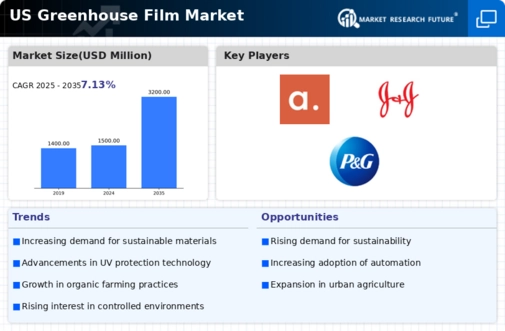The greenhouse film market exhibits a dynamic competitive landscape characterized by innovation and strategic partnerships. Key players such as Berry Global Inc (US), AEP Industries Inc (US), and Coveris Holdings S.A. (US) are at the forefront, each adopting distinct operational focuses. Berry Global Inc (US) emphasizes sustainability in its product offerings, aligning with the growing demand for eco-friendly solutions. AEP Industries Inc (US) appears to be concentrating on expanding its manufacturing capabilities to enhance supply chain efficiency. Meanwhile, Coveris Holdings S.A. (US) is likely leveraging digital transformation to optimize its production processes, thereby improving operational agility. Collectively, these strategies contribute to a competitive environment that is increasingly shaped by sustainability and technological advancement.
In terms of business tactics, localizing manufacturing and optimizing supply chains are pivotal for these companies. The market structure is moderately fragmented, with several players vying for market share. This fragmentation allows for diverse product offerings, yet the influence of major companies remains substantial, as they set benchmarks for quality and innovation. The collective actions of these key players not only drive competition but also foster an environment conducive to growth and development within the sector.
In November 2025, Berry Global Inc (US) announced a partnership with a leading agricultural technology firm to develop biodegradable greenhouse films. This strategic move underscores Berry's commitment to sustainability and positions the company to capture a growing segment of environmentally conscious consumers. The collaboration is expected to enhance Berry's product portfolio and reinforce its market leadership.
In October 2025, AEP Industries Inc (US) unveiled a new manufacturing facility in Texas, aimed at increasing production capacity for greenhouse films. This expansion is significant as it not only bolsters AEP's operational capabilities but also reflects a strategic response to rising demand in the agricultural sector. The facility is anticipated to create numerous jobs, further embedding AEP within the local economy and enhancing its brand reputation.
In September 2025, Coveris Holdings S.A. (US) launched an advanced digital platform designed to streamline its supply chain operations. This initiative is indicative of the company's focus on digital transformation, which is likely to improve efficiency and reduce costs. By integrating technology into its operations, Coveris positions itself to respond more adeptly to market fluctuations and customer needs.
As of December 2025, current trends in the greenhouse film market are increasingly defined by digitalization, sustainability, and the integration of AI technologies. Strategic alliances are becoming more prevalent, as companies recognize the value of collaboration in enhancing innovation and market reach. Looking ahead, competitive differentiation is expected to evolve, shifting from price-based competition to a focus on innovation, technological advancement, and supply chain reliability. This transition suggests that companies that prioritize these elements will likely secure a more robust position in the market.














Leave a Comment